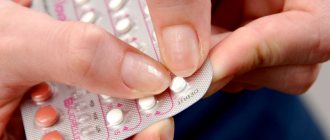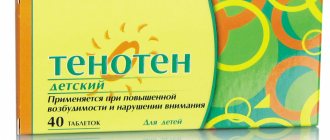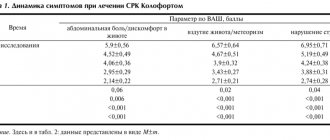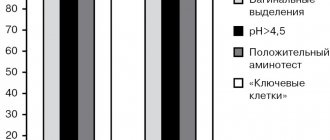Chemical properties
Thioridazine is an antipsychotic drug. It has antipsychotic and moderate antidepressant effects. In the form of hydrochloride , it is a white powder that is highly soluble in water and ethyl alcohol, chloroform , methanol , and insoluble in ethers . The drug is produced in the form of film-coated tablets with different dosages. Due to the high incidence of life-threatening arrhythmias and retinopathy , the drug is used strictly according to indications and when other drugs are ineffective. In some countries the medicine has been withdrawn from circulation.
Pharmacodynamics and pharmacokinetics
The mechanism of action of Thioridazine is based on the ability of the drug to disrupt adrenergic and dopaminergic transmission of nerve impulses, especially in the reticular formation of the brain. The substance eliminates the activating effect on the limbic system and cerebral cortex. The drug provides blocking of m-cholinergic receptors , significantly reducing the activity of the autonomic nervous system.
The chemical compound affects various psychomotor functions, reduces general arousal, mobility, eliminates agitation and the degree of affective tension. The medicine also has a sedative effect, but does not lead to general lethargy and lethargy. It has some antidepressant and activating effects, moderate sedative and anticholinergic. Does not have a cataleptogenic effect, reduces blood pressure .
After taking the tablets, their contents are quickly absorbed in the digestive tract. The maximum concentration is observed after 1-4 hours. The drug quickly overcomes the histohematic barriers, the blood-brain and placental barriers, and is excreted in breast milk. The product has a high degree of bioavailability.
Metabolized in the liver with the participation of the cytochrome CYP2D6 to sulforidazine and mesoridazine (active metabolites). The half-life from the body ranges from 6 to 40 hours. The medicine is excreted through the kidneys, with bile. The mesoridazine metabolite is more active than the substance itself; it has a longer elimination time from the body, but a lower degree of binding to blood proteins.
Thioridazine
Release form, composition and packaging
Light pink to pink film-coated tablets, round, biconvex; On a cross section, two layers are visible.
1 tab. thioridazine hydrochloride 10 mg.
Excipients: potato starch, colloidal silicon dioxide (Aerosil), lactose monohydrate, gelatin, talc, calcium stearate, sugar, low molecular weight medical polyvinylpyrrolidone (povidone), pigment titanium dioxide, basic magnesium carbonate, acid red dye 2C, bee wax.
Film-coated tablets from light yellow to yellow with a greenish tint, round, biconvex; On a cross section, two layers are visible.
1 tab. thioridazine hydrochloride 25 mg.
Excipients: potato starch, colloidal silicon dioxide (Aerosil), lactose monohydrate, gelatin, talc, calcium stearate, sugar, low molecular weight medical polyvinylpyrrolidone (povidone), pigment titanium dioxide, basic magnesium carbonate, yellow water-soluble dye KF-6001, bee wax.
Clinical and pharmacological group: Neuroleptic.
pharmachologic effect
Antipsychotic drug, antipsychotic, piperidine phenothiazine derivative, affecting the central nervous system and peripheral nervous system. It has antipsychotic, tranquilizing, antidepressant, antipruritic and antiemetic effects.
The mechanism of antipsychotic action is associated with blockade of postsynaptic dopaminergic receptors in the mesolimbic structures of the brain. The antiemetic effect is due to inhibition or blockade of dopamine D2 receptors in the chemoreceptor trigger zone of the cerebellum. It also has sympatholytic and m-anticholinergic effects. In small doses it has an anxiolytic effect, reduces feelings of tension and anxiety, and in higher doses it exhibits antipsychotic (neuroleptic) properties. Antihistamine and anticholinergic effects are most pronounced among all drugs from the group of antipsychotics. In average therapeutic doses it does not cause extrapyramidal disorders or drowsiness. It has an alpha-adrenergic blocking effect and suppresses the release of pituitary and hypothalamic hormones, however, blockade of dopamine receptors increases the release of prolactin by the pituitary gland.
Pharmacokinetics
Suction and distribution
After taking the drug orally, thioridazine is highly absorbed from the gastrointestinal tract, with Cmax in the blood plasma reached within 1-4 hours. Plasma protein binding is about 90%. Excreted in breast milk.
Metabolism and excretion
Metabolized in the liver to form active metabolites (mesoridazine and sulforidazine). T1/2 varies from 6 to 40 hours. Mesoridazine is pharmacologically more active than thioridazine, has a larger T1/2 value, is less bound to plasma proteins, and the concentration of the free fraction is higher than that of thioridazine. It is excreted by the kidneys (about 35%) and with bile unchanged and in the form of metabolites.
Indications
- schizophrenia;
- affective insanity;
- neuroses accompanied by fear, anxiety, excitement, tension, depressed mood, sleep disturbances, obsessive states;
- psychotic disorders accompanied by hyperreactivity and agitation;
- severe behavioral disorders associated with aggressiveness, inability to concentrate for long periods of time;
- withdrawal syndrome (substance abuse, alcoholism);
- psychomotor agitation of various origins;
- moderate to severe depression in adults;
- Huntington's disease, tics;
- skin diseases that occur with severe and painful itching;
- in child psychiatry - behavioral disorders with increased psychomotor activity.
Dosage regimen
Installed individually.
For acute psychoses, mania, schizophrenia and agitated states on an outpatient basis, a dose of 150-400 mg/day is prescribed; in the hospital - 250-800 mg/day. Treatment is usually started with a low dose (25-75 mg/day), gradually (over 7 days) increasing it to the optimal therapeutic dose. The antipsychotic effect is observed after 10-14 days.
The duration of therapy is several weeks.
For maintenance therapy, the drug is taken at a dose of 75-200 mg/day once a day before bedtime.
For elderly patients, the drug is usually prescribed in lower doses: 30-100 mg/day.
The drug should be discontinued gradually.
For mild emotional disorders, the recommended dose is 30-75 mg/day; for disorders of moderate severity - 50-200 mg/day. Treatment should begin with low doses, gradually increasing them to the optimal therapeutic dose.
For psychosomatic disorders, the drug is prescribed at 10-75 mg/day.
When treating severe itching, the dose of the drug is determined individually and should not exceed 200 mg.
For children, the dose of the drug is set depending on age: at the age of 4 to 7 years – 10-20 mg/day, dosage frequency 2-3 times/day; from 8 to 14 years the drug is prescribed at a dose of 20-30 mg/day, dosage frequency 3 times/day, from 15 to 18 years - 30-50 mg/day; dosage frequency 3 times/day.
Side effect
From the central nervous system: confusion, tardive dyskinesia, agitation, agitation, insomnia, extrapyramidal and dyspeptic disorders, parkinsonism, emotional disturbances, thermoregulation disorders, decreased seizure threshold, fainting, visual impairment, photophobia.
From the digestive system: hyposalivation, anorexia, increased appetite, nausea, vomiting, diarrhea, intestinal obstruction, weight gain, hypertrophy of the tongue papillae; rarely - cholestatic hepatitis.
From the cardiovascular system: hypotension, tachycardia.
From the hematopoietic system: in isolated cases - granulocytopenia, agranulocytosis, leukopenia, eosinophilia, thrombocytopenia, aplastic anemia, pancytopenia.
From the urinary system: paradoxical ischuria, dysuria.
From the reproductive system: decreased libido, impaired ejaculation, dysmenorrhea, hyperprolactinemia, gynecomastia, priapism, false-positive pregnancy tests.
Allergic reactions: skin reactions, erythema, rash, exfoliative dermatitis; angioedema, bronchospastic syndrome, nasal congestion.
Other: melanosis of the skin (with long-term use in high doses).
Contraindications
- acute depressive states;
- comatose states of any etiology;
- traumatic brain injuries;
- progressive systemic diseases of the brain and spinal cord;
- severe cardiovascular failure;
- severe arterial hypotension;
- pheochromocytoma;
- porphyria;
- blood diseases (hypo- and aplastic processes);
- pregnancy;
- lactation;
- age up to 4 years;
- hypersensitivity to the components of the drug.
With caution: alcoholism (predisposition to hepatotoxic reactions), pathological changes in the blood (hematopoietic disorders), breast cancer (as a result of phenothiazine-induced prolactin secretion, the potential risk of disease progression and resistance to treatment with endocrine and cytotoxic drugs increases), angle-closure glaucoma, prostate hyperplasia with clinical manifestations, liver and/or kidney failure, peptic ulcer of the stomach and duodenum (in the acute stage); diseases accompanied by an increased risk of thromboembolic complications; Parkinson's disease (extrapyramidal effects increase); epilepsy; myxedema; chronic diseases accompanied by breathing problems (especially in children); Reye's syndrome (increased risk of hepatotoxicity in children and adolescents); cachexia, vomiting (the antiemetic effect of phenothiazines may mask vomiting associated with an overdose of other drugs); elderly age.
Pregnancy and lactation
The drug is contraindicated for use during pregnancy and lactation.
Use for liver dysfunction
With caution: alcoholism, liver failure.
Use for renal impairment
With caution: renal failure.
special instructions
During use of the drug, it is necessary to monitor the morphological composition of the blood.
You should refrain from drinking alcohol.
Impact on the ability to drive vehicles and operate machinery
Patients taking the drug should not engage in potentially hazardous activities that require increased attention.
Indications for use
The medicine is prescribed:
- for the treatment of psychotic disorders and schizophrenia , which are accompanied by excessive agitation and hyperactivity ;
- for severe behavioral disorders, aggression, frustration, inability to concentrate, associated with psychotic disorders and neurological diseases;
- patients with severe or moderate depression in adults;
- for neuroses with agitation, anxiety, tension, insomnia , fears;
- for the treatment of Huntington's disease .
Use of the drug Thioridazine
The dose and time of administration are determined individually. As an anxiolytic, adults are prescribed a daily dose of 10-75 mg, children aged 1 year and older - 0.5-2 mg per 1 kg of body weight. As an antipsychotic for psychosis in adults, thioridazine is used in a hospital setting at a daily dose of 100–600 mg, on an outpatient basis - 50–300 mg, for agitated depression and when used in geriatrics - 25–300 mg, for alcohol withdrawal - 100–200 mg, for severe mental disorders of a non-psychotic nature - 25–150 mg. The maximum daily dose for adults is 800 mg, for children aged 1 year and older - 1-4 mg per 1 kg of body weight. When prescribing a dose close to the maximum daily dose, it is divided into 2–4 doses. Treatment of patients with underweight, kidney and liver diseases, as well as elderly patients is recommended to begin with the lowest doses and increase them very slowly. Thioridazine can be used to treat behavioral disorders in patients with epilepsy; in such cases, anticonvulsants should be continued, increasing their doses if necessary.
Contraindications
Thioridazine is not recommended for use:
- for acute depression ;
- patients in a coma , with severe depression of the central nervous system;
- for severe diseases of the heart and blood vessels, blood diseases ( arterial hypertension , chronic heart failure, arterial hypotension , arrhythmia );
- children under one year old;
- if you are allergic to a substance;
- patients with traumatic brain injury;
- in combination with drugs that prolong the QT interval, with CYP2D6 ;
- for porphyria , pregnancy and breastfeeding.
There are also some restrictions when treating the following groups of patients:
- alcoholics;
- patients with hematopoietic disorders;
- breast cancer patients ;
- patients with angle-closure glaucoma , prostatic hyperplasia ;
- patients with renal and liver failure, epilepsy , myxedema ;
- ulcers, especially during exacerbation;
- patients with chronic diseases that are accompanied by impaired respiratory function;
- patients with Reye's syndrome and the elderly.
Side effects
During treatment with the drug, the following may occur:
- drowsiness , confusion , fainting, agitation , severe central nervous system agitation, hallucinations , sleep disturbances, convulsions , dystonia and parkinsonian extrapyramidal disorders;
- photophobia , vomiting, blurred vision, problems with thermoregulation, hyposalivation , indigestion , diarrhea or constipation , cholestatic hepatitis ;
- amenorrhea , gynecomastia , galactorrhea , dysmenorrhea , weight gain, swelling of the mammary glands;
- tachycardia , drop in blood pressure, changes in the electrocardiogram, leukopenia , agranulocytosis , thrombocytopenia ;
- pancytopenia , nasal congestion, dysuria , bronchospastic syndrome, urinary retention, priapism , sexual dysfunction, changes in libido ;
- skin rashes, dermatitis , Quincke's edema , swelling, melanosis of the skin.
Cases of sudden death of patients caused by disturbances in the functioning of the heart have been reported.
Side effects of the drug Thioridazine
Common side effects, especially when using a high dose and early in treatment, include drowsiness, sedation, dizziness, nasal congestion, and dry mouth. Dose-dependent orthostatic hypotension is sometimes observed, especially in elderly patients. Other dose-related effects associated with the anticholinergic activity of thioridazine include disturbances of accommodation, tachycardia, constipation, and urinary retention or incontinence. In some patients, thioridazine, even in low doses, can cause a feeling of mental depression, nausea, dizziness, headache, or, conversely, paradoxical effects of agitation, agitation or insomnia. In some cases, neuroleptic malignant syndrome (muscle rigidity, hyperthermia, mental status disorders, autonomic lability) was observed, requiring immediate discontinuation of thioridazine. When used in high doses, as with other phenothiazines, ECG changes of the repolarization type are described (lengthening of the Q-T , flattening of the T and appearance of the U ). These changes are most likely due to a decrease in potassium concentration in the blood. Like all phenothiazines, thioridazine can in rare cases provoke arrhythmias. Cases of sudden unexplained death, possibly due to arrhythmia or cardiac arrest, have been reported among patients receiving tricyclic antipsychotics, including thioridazine. When prescribing high (neuroleptic) doses of thioridazine, extrapyramidal symptoms are possible; when using low (anxiolytic) doses they are practically not observed. There have been reports of cases of pigmentary retinopathy during long-term treatment with thioridazine, mainly when taking more than 800 mg of thioridazine per day. Antipsychotic drugs such as thioridazine can cause hyperprolactinemia, leading to galactorrhea, menstrual irregularities, erectile dysfunction (weakness of erection or priapism) and ejaculation, and sometimes weight gain and edema. These effects can be prevented by reducing the dose of thioridazine. Rare cases of leukopenia and agranulocytosis, especially in the first months of treatment, photosensitivity, allergic rash, jaundice, hepatitis and liver dysfunction have been described.
Thioridazine, instructions for use (Method and dosage)
The medicine has an individual dosage regimen. The treatment regimen is determined by the attending physician, depending on many factors.
On average, adults over the age of 12 years are prescribed from 20 to 800 mg of the drug per day, 3 times a day. High dosages of medication can be prescribed for no more than 5 weeks.
For children, it is necessary to adjust the dosage depending on weight and age.
The maximum daily dosage for an adult (from 12 years old) is 0.8 g.
Interaction
Simultaneous use with drugs that depress the central nervous system and ethyl alcohol leads to increased sedative properties of the drug.
The medicine reduces the effectiveness of anticonvulsants and cimetidine .
Thioridazine enhances the effect of anticholinergics and sympathomimetics.
The combined use of the drug with drugs that lower blood pressure leads to an even greater decrease in blood pressure and the development of orthostatic hypotension .
When combined with appetite suppressants other than fenfluramine , this substance significantly reduces their effectiveness.
Simultaneous use of the drug with anticoagulants leads to a decrease in their effectiveness; with antithyroid drugs – to the development of agranulocytosis ; with beta-blockers - leads to increased hypotensive effect. The drug increases the risk of arrhythmias , tardive dyskinesia , and retinopathy .
Hypoglycemic agents lose their effectiveness when used with Thioridazine.
The combined use of the drug with amphetamine leads to a mutual weakening of the properties of both drugs.
With the simultaneous use of this substance and apomorphine , the emetic effect of the latter is reduced and the sedative effect is enhanced.
The medicine causes an increase in the concentration of prolactin in the blood and reduces the effectiveness of bromocriptine .
The drug can reduce the effectiveness of levodopa and guanethidine .
The combined use of the drug with probucol , cisapride , astemizole , disopyramide , pimozide , erythromycin , procainamide leads to prolongation of the QT interval and the development of ventricular tachycardia .
Thioridazine reduces the rate of absorption of lithium salts from the digestive tract and increases the rate of excretion of lithium ions from the body. The drug is also able to mask some signs of acute lithium intoxication, vomiting, and nausea.
hyponatremia increases ; with trazodone – its concentration in the blood increases.
The drug reduces the plasma concentration of phenobarbital .
The combined use of the drug and quinidine increases the load on the heart and can lead to prolongation of the QT interval and tachycardia .
Concomitant use with epinephrine causes a sharp decrease in blood pressure .
Drug interactions Thioridazine
Thioridazine, like other phenothiazines, can enhance the inhibitory effect on the central nervous system of alcohol, central nervous system depressants and antihistamines, the M-anticholinergic effect of anticholinergics and the inhibitory effect of quinidine derivatives on the myocardium. Thioridazine can reduce the severity of the antiparkinsonian effect of levodopa, reduce the seizure threshold in patients with epilepsy (which may require changing the dose of anticonvulsants), and reduce the pressor effect of adrenergic vasoconstrictors. MAO inhibitors may enhance or prolong the sedative and antimuscarinic effects of phenothiazines. Concomitant use of lithium preparations contributes to the development of extrapyramidal symptoms and increased neurotoxic properties of thioridazine. Taking beta-adrenergic receptor blockers may cause an increase in the concentration of thioridazine in the blood plasma. The absorption of thioridazine may be impaired by antacids and antidiarrheal drugs.
special instructions
During treatment, it is recommended to monitor liver function, peripheral blood composition, heart function, and the general condition of the patient.
During therapy, you should not drive a car or perform potentially dangerous actions that require high reaction speed.
Thioridazine, more often than other representatives of a number of phenothiazines , causes visual impairment, pigmentary retinopathy , and hemeralopia .
When treated with this substance, tardive dyskinesia . The risk is higher in women and during treatment with high doses of the drug. In some cases, these types of symptoms are irreversible. If adverse reactions develop, the drug is discontinued and symptomatic treatment is carried out.
Special instructions for the use of the drug Thioridazine
Caution is required when using thioridazine for narrow-angle glaucoma, prostatic hypertrophy and cardiovascular diseases. Thioridazine causes leukopenia or agranulocytosis relatively rarely, however, in the first months of treatment it is recommended to regularly count blood cells, and if clinical signs of pathological changes in blood composition appear, do so immediately. In case of liver diseases, regular monitoring of its functional state is necessary. Persons taking thioridazine should be careful when driving or operating potentially dangerous machinery. During pregnancy, thioridazine is prescribed only for absolute indications. Breastfeeding should be interrupted during treatment with thioridazine.
Drugs containing (Thioridazine analogues)
Level 4 ATC code matches:
Thiodazine
Thioril
Neuleptil
Sonapax
There is a large selection of structural analogues (synonyms) of this drug. The most common synonyms of Thioridazine: Ridazine , Melleril , Thioril , Sonapax , Thiodazine , Tison .
Reviews
Reviews of Thioridazine drugs are mostly positive; it is often prescribed to children and used as a sedative or antidepressant . Some prefer, in order to avoid adverse reactions, to take glycine .
Some reviews about the drug:
- “... The drug was prescribed for insomnia, neurosis and anxiety. The medicine seemed quite effective to me, I went through everything fine with it, and stood firm through everything. There were no adverse reactions at all”;
- “... My son was prescribed medication for hyperactivity. So the drug seemed to help, but the side effects were very strong: dizziness, vomiting, the child turned into a vegetable. In short, they stopped taking pills, changed the doctor, and at the same time the treatment tactics”;
- “... I took this remedy, it seemed to help me, but severe drowsiness and visual disturbances forced me to stop the course of treatment.”




